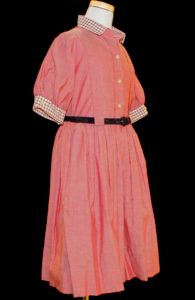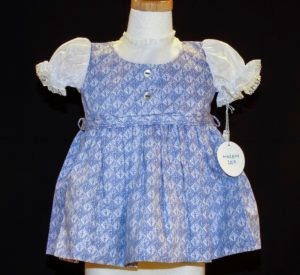Helen Lee and Joseph Love, Inc.
Interview With Stella Blum Student Research Grant 2015 Awardee, Jennifer Farley Gordon
I am the chair of the Stella Blum Student Research Grant. This grant, awarded annually and funded by the CSA endowment, provides up to $2000 to assist a currently enrolled student who is researching an aspect of North American costume. A group of five anonymous jurors convenes via conference call every summer to review the applications and choose an awardee.
I was asked to interview the 2015 awardee, Jennifer Farley Gordon. Dr. Gordon was enrolled in the Apparel, Merchandising, and Design program at Iowa State University. Her advisor was Dr. Sara Marcketti. I asked questions via e-mail, and here are her responses. – Ann Wass
Tell us a bit about your research topic and how you came to choose it.
My research examined the development of the children's wear industry during the period of 1920 through 1969 from the perspective of select industry insiders: significant manufacturers (such as Joseph Love, Inc.) and designers (such as Helen Lee), as well as the journalists who covered the trade during the period. I wanted to discuss the histories of specialist children's wear designers and companies because it seemed to be a subject about which little had been written. During this period, a number of women's wear designers branched out into children's clothing, and I also wanted to understand the changes to the industry that resulted from their entrance into the children's clothing field.
I knew that I wanted to focus on mid-twentieth century children's wear before I entered ISU's doctoral program. I first encountered the name Helen Lee while researching my master's thesis on matching mother-daughter fashions from the 1920s-1960s. Over the years, I built up a little file of material related to children's wear and designer names during the mid-twentieth century. It was enough to convince me that there was something there. When I arrived at ISU, Dr. Marcketti and I had many conversations on how to refine the topic.
How did you find out about the Stella Blum Student Research Grant?
Dr. Marcketti thought that my research topic was a good fit for the grant and she encouraged me to apply.
What was your initial plan for the portion of your research to be funded by the grant?
My initial proposal sought to focus on case studies of two key industry players, Joseph Love, founder of an eponymous children’s wear firm, and Helen Lee, a leading children’s wear designer. I planned to visit archives in New York City that held material about those individuals.
I understand that, as is sometimes the case, you made what you describe as a “significant change†to your proposed research. Tell us about that.
In my dissertation, I discuss both Joseph Love and Helen Lee extensively, but once I began to collect and analyze data, it became clear that I needed to broaden the scope of the discussion beyond those two case studies alone.
As the research evolved, I found a hypothesis posited by Joseph Love’s son, Robert, which I used as a framework for evaluation of the chosen case studies. Robert Love proposed that, by the 1960s, two distinct phases had occurred in the development of children’s ready-to-wear garment manufacturing in the United States. Love believed that the first phase was the growth in influence and size of a number of children’s wear manufacturing brands. The second phase was the entrance of skilled specialist designers.
For both case studies, I sought out contextual information about other children’s wear manufacturers and designers, particularly in the discussion of specialist children’s wear designers. Based on my research, I chose to include two of Helen Lee’s peers—Suzanne Godart and Betsy Daniels—as the three were reported to be among the first children’s wear designers to receive credit on the label.
Additionally, I had to alter the way I planned to disseminate the information. The archival information was so rich and in the case of the Joseph Love Collection at FIT, so plentiful. Rather than try to discuss both case studies in a single article, I plan to focus on Joseph Love in the Stella Blum Grant Report for Dress, while discussion of the specialist designers will appear in a forthcoming edited compilation on twentieth-century American designers from Bloomsbury.
What did the grant specifically enable you to do?
The grant enabled me to travel from Iowa to New York City for three weeks to conduct daily research visits to archives. It will also allow me to pay for the rights to use some of the fabulous archival images when the accompanying article is published in Dress.
Give us an overview of the libraries, archives, and special collections you visited on your funded trip.
I visited the Kellen Design Archives at Parsons The New School, which is the repository for the Saks Fifth Avenue Fashion Publicity Collection. The collection contains records related to Helen Lee’s work from the 1960s and early 1970s (largely press photographs and press releases). I learned from the archivist that Lee also acted as a critic for student work, and was able to see some of the examples of illustrated designs for which she provided feedback.
The greatest volume of source material was found at the Department of Special Collections and FIT Archives at the Fashion Institute of Technology Library in New York City. The archive contains oral histories from designer Helen Lee and children’s wear executive Stanley Love (son of Joseph Love), as well as a large collection of company records, scrapbooks, photographs, and marketing memos from Joseph Love, Inc. Highlights of the examined material included detailed sketches of full seasonal lines from the 1940s and 1950s, as well as documents related to company patents, and company records detailing marketing and sales strategies.
I also visited two branches of the New York Public Library. At the main facility, in the Manuscripts and Archives Division, there was one folder of documents and photographs of Helen Lee as part of the Fashion Group International Records collection. The Science, Industry, and Business Library holds bound volumes of The Infants’ and Children’s Review, which I reviewed to supplement my understanding of the children’s wear industry.
The Endowment also provides a stipend to make it possible for you to attend an annual symposium to present your research. I understand you plan to attend the 2017 symposium in Portland, Maine, where we will be hearing your report. Can you give us a preview of one or two revelations from your funded research?
A central theme of the first phase of industry development and the history of Joseph Love, Inc. was about building a dominant brand identity within a burgeoning industry. Love positioned itself as mass-market, but with products of high quality bearing a desirable brand name. By the 1950s, the company had a fairly focused brand image, but I was surprised to find that was not the case in its earlier years. During the 1930s, Love had numerous branded lines under its umbrella, including Princess Elizabeth Frocks by Love, Jane Withers Frocks by Love, Cinema Fashions and Colleen Moore Doll House Frocks. To help distinguish itself within a complex and competitive field, and to address the child consumer, Joseph Love, Inc. capitalized on connections to popular culture through licensed product agreements with the entertainment industry.
In terms of Helen Lee, her work at Youngland, beginning in 1950, appears to be mark one of the earliest examples of the children’s wear designer name on a garment label. She had been working in relative anonymity for almost two decades by that point. Her contemporary, Suzanne Godart, received her name on the Suzy Brooks label around the same time. The press considered Lee and Godart to be part of the “first†generation of children’s wear specialists, who paved the way, with regard to name recognition, for those like Betsy Daniels in the 1960s.
Now that you have finished your degree, what’s next professionally?
To be determined! Since graduating, I’ve been looking for freelance writing projects. There is a group of our peers working on digitization and accessibility related to museum collections (something I’m very interested in). Now that I have a little more free time, I’m hoping to become more involved with them. Eventually I’d love to work with a museum collection again.
I believe you were involved with CSA before you received your award, and we would love to see you continue your involvement with the Society. I’m not asking for any firm commitments, but any thoughts as to how you might participate in the future?
I was able to help organize the Marketplace for Cleveland, which was my first chance to give back to the organization. That opportunity presented itself during a conversation over lunch at the conference in San Antonio. While I’m not sure of specifics, I am eager to be more involved and on the lookout for ways to do so.
Anything else you would like to add?
I'd like to add my thanks to the Endowment and to the members of CSA for their support! I received wonderful feedback after presenting my preliminary research on Helen Lee at the conference in San Antonio. I had difficulty locating Helen Lee’s garments in museum collections, but after speaking with Myra Walker at the conference, I learned that the Texas Fashion Collection has an amazing example of sister dresses Lee designed for the brand Youngland.
I'm also very grateful to the wonderful archivists and curators who make these resources available for research.
Illustration Left: Joseph Love, Inc., dress, cotton, c. 1952. From the collection of the Textiles and Clothing Museum, Iowa State University, 3700.
This dress was reportedly part of an Iowa State University faculty research study comparing synthetic and natural fibers, funded by DuPont.
Illustration Right: Helen Lee for Saks Fifth Avenue, dress, Spring 1961. From the personal collection of the author. Photograph by Minor Gordon.
During the course of my research, I began collecting examples of garments designed by Helen Lee, Suzanne Godart, and Betsy Daniels. I purchased this dress from a seller on Etsy. It had its original store tags, but no provenance. One of the best moments during my research trip was to open a binder at the Kellen Design Archives and see a press photograph of this dress staring back at me. It is from Helen Lee’s first collection for Saks Fifth Avenue, Spring 1961.


